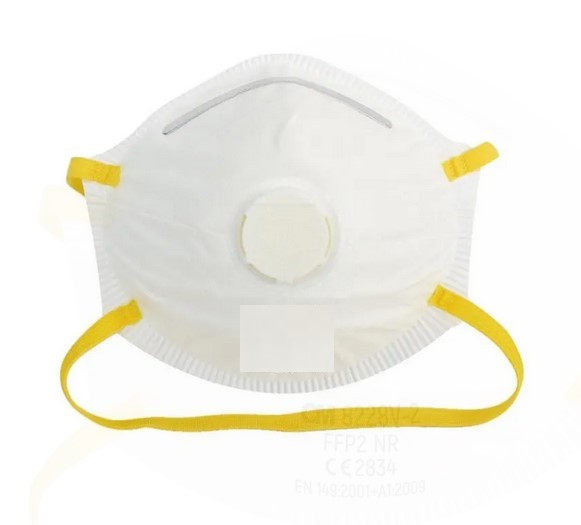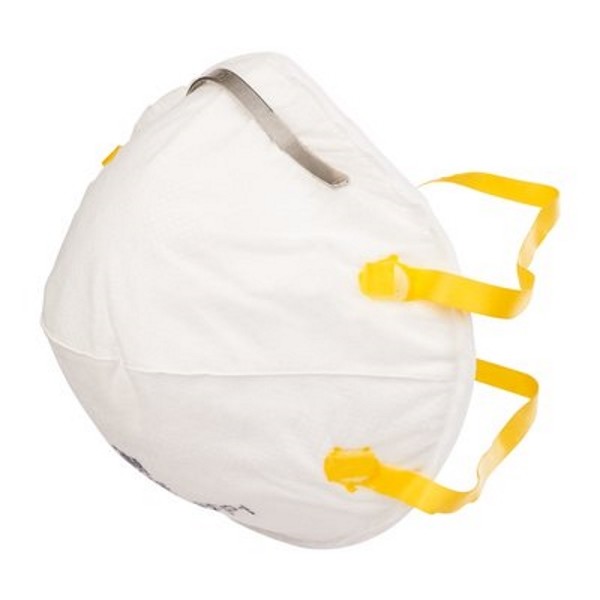RESPIRATOR FFP2/N95, valved, cup-shaped, disposable
Valid Article
RESPIRATOR, disposable
Definition
Personal Protective Equipment (PPE) for general use
A device intended to be placed over the nose and mouth with a filtering face piece (FFP) for respiratory protection against dust, as well as solid and liquid aerosols.
It is made of a flexible, porous fabric material that enables the user to breathe normally through the mask, and is held in place with ties that fasten at the back of the user's head.
A respirator with an exhalation valve does provide the same level of protection to the wearer as one that does not have a valve. The presence of an exhalation valve reduces exhalation resistance, which makes it easier to breathe (exhale). Some users feel that a respirator with an exhalation valve keeps the face cooler and reduces moisture build up inside the facepiece. However, respirators with exhalation valves should not be used in situations where a sterile field must be maintained (e.g., during an invasive procedure in an operating or procedure room) or if the wearer is potentially infected by an airborne micro-organism because the exhalation valve allows unfiltered exhaled air to escape into the sterile field.
Specifications
Norms
Meets the specifications of either one of the following PPE norms or equivalent:
- European norm FFP (EN 149+A1: 2009 "Respiratory protective devices - Filtering half masks to protect against particles - Requirements, testing, marking")
- American norm N95 (US NIOSH certification according: Respiratory Protective Devices, 42 CFR Part 84)
Most N95 respirators are manufactured for use in construction and other industrial type jobs that expose workers to dust and small particles. They are labeled "For occupational use".
Technical specifications
- Polypropelene, polyester, polyethylene, aluminium
- Meets the requirements of FFP class (see table below)
- Filtration efficiency with 0.3 µm particles
- Total Inward Leakage (TIL)
- Penetration of the filtering material (NaCl and paraffine at 95 l/min with particles of 0.6 µm)
- Covers the nose, the mouth and the chin and providing a tight seal around the edge
- Does not collapse against the mouth
- Strong elastic straps
- With or without valve
- Non sterile, for single use
| Filtering Facepiece Protection class | FFP1 | FFP2 | FFP3 |
| Filter penetration limit (at 95 L/min air flow): Filters at least xx% of airborne particles | 80% | 94% | 99.95% |
Penetration of filter material: 9 samples to test for each aerosol (Sodium chloride / paraffin oil, 95l/min, % max | 20% | 6% | 1% |
| TIL: at least 46 out of the 50 individual exercise results (i.e.10 subjects x 5 exercises) | <25% | <11% | <5% |
TIL: at least 8 out of the 10 individual wearer arithmetic means for the TIL shall be not greater than | 22% | 8% | 2% |
Breathing resistance: Maximum permitted resistance (mbar) - Inhalation 39l/min - Inhalation 95L/min - Exhalation 160l/min | 0.6 2.1 3.0 | 0.7 2.4 3.0 | 1.0 3.0 3.0 |
The different types indicate different protective levels, measured in Occupational Exposure Limit (OEL) of the substance present in the work environment. One OEL equals the exposure limit if unprotected, the OELs given for each FFP indicate the increasing protection levels.
- FFP1 - low level of protection up to 4x OEL, suitable for cleaning, drilling, and cutting.
- FFP2 - medium level of protection up to 12x OEL, minimum protection requirement for waste management and spraying of chlorine or insecticide.
- FFP3 - high level of protection up to 12x OEL, suitable for handling hazardous powders.
Instructions for use
Only put on and take off the respirator in dust or contaminant free environment. Ensure a proper seal between the respirator and the face by folding the metallic strip around the nose and the plastic straps around the ears.
Replace the FFP when breathing resistance becomes too strong or in case of a strange smell.
Do not use FFPs:
- in environments where oxygen may be lacking or only poor ventilation given, such as in tanks, small rooms, tunnels or vessels.
- when toxic contaminants and their concentration are unknown or immediately dangerous to life or health.
- fire fighting
Every time a respirator is put on, PERFORM A SEAL CHECK
Stand in front of a mirror and fully open the respirator
STEP 1: Cup the respirator in your hand with the nosepiece at your fingertips
STEP 2: Position the respirator under your chin with the nosepiece up in order to cover the chin, the mouth and the nose
STEP 3: Pull the top strap over your head resting it high at the back of your head. Pull the bottom strap over your head and position it around the neck below the ears
STEP 4: Mould the nosepiece (using two fingers of each hand), to the shape of your nose
STEP 5: Cover the respirator with both hands, being careful not to disturb the position of the respirator
- Inhale deeply in order to create an air vacuum: if the seal is good, the respirator will cling to your face
- Exhale sharply: if the seal is good, the respirator will slightly expand
- Inhale and exhale several times: no leakage of air between the face and the respirator may be detected
If problems are met (the respirator does not collapse neither expand or if air leak is detected), adjust the respirator and retest the seal. In case the problems persist, replace the respirator and/or try another model or size. Once the respirator is correctly fitted, don't manipulate it any longer.
Storage
- Store between 5 and 40°C
- In a dry and well-ventilated place





![[PSAFMASKR1VC] RESPIRATOR FFP1, valved, cup-shaped, disposable](/web/image/product.template/548129/image_256/%5BPSAFMASKR1VC%5D%20RESPIRATOR%20FFP1%2C%20valved%2C%20cup-shaped%2C%20disposable?unique=e981ce9)
![[PSAFMASKR2NV] RESPIRATOR FFP2/N95, unvalved, vertical fold, disposable](/web/image/product.template/561556/image_256/%5BPSAFMASKR2NV%5D%20RESPIRATOR%20FFP2-N95%2C%20unvalved%2C%20vertical%20fold%2C%20disposable?unique=2aeadab)
![[PSAFMASKR2VV] RESPIRATOR FFP2/N95, valved, vertical fold, disposable](/web/image/product.template/561548/image_256/%5BPSAFMASKR2VV%5D%20RESPIRATOR%20FFP2-N95%2C%20valved%2C%20vertical%20fold%2C%20disposable?unique=d428413)
![[KWATMPPEB--] MODULE, PPE, basic, for 1 Watsan operator](/web/image/product.template/551942/image_256/%5BKWATMPPEB--%5D%20MODULE%2C%20PPE%2C%20basic%2C%20for%201%20Watsan%20operator?unique=a243103)
![[KWATMPPEWM-] MODULE, PPE, medical waste management, for 2 operators](/web/image/product.template/551954/image_256/%5BKWATMPPEWM-%5D%20MODULE%2C%20PPE%2C%20medical%20waste%20management%2C%20for%202%20operators?unique=a243103)